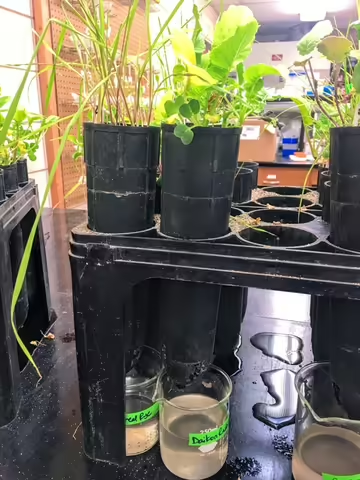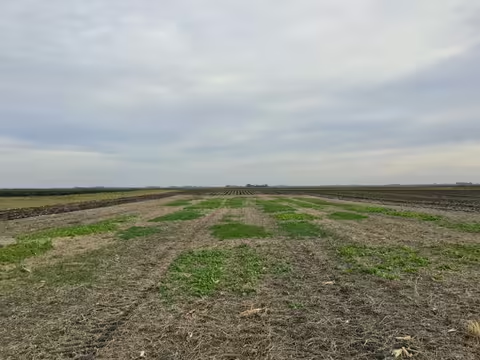I think it is high time that I write to inform you about my Ph.D. research at Iowa State University where I studied the impact of cover crops on the soybean cyst nematode (SCN).
When I started my Ph.D. at Iowa State in 2015, the topic of cover crops and SCN was *fire emoji* hot! And when offered the opportunity to make this research question my topic of interest, I hopped on it. I’ll share here not only my research findings but also a bit about what other past research has found on the subject.
What are the possible outcomes of an interaction between cover crops and SCN:
- The cover crop inadvertently increases SCN population densities (if the species used are adequate hosts for SCN reproduction).
- There is no effect of cover crops on SCN population densities.
- The cover crop decreases SCN population densities through some hypothesized mechanisms.
Obviously, outcome three is of the most interest. But it is important to first consider the potential of different cover crop species to serve as a host for SCN. The host status of different plant species had previously been documented (Kobayashi et al., 2017). However, very few cover crop species were represented in that study. In a separate study published in 2017, researchers found low reproduction potential on some leguminous cover crop species (including Austrian winter pea and hairy vetch) and no SCN reproduction potential on grass cover crop species (cereal rye and annual ryegrass) or cultivars of brassica species (oilseed radish, Daikon-type radish, mustard, rapeseed).
Onto the most “interesting” potential outcome of an interaction between cover crops and SCN. Now, I have to tell you that based on cover crop seed marketing, I was really excited to dig into the project. However, after completing my literature review of previously published research studies, I proceeded with more caution.
The trends in the literature were highly inconsistent, insignificant, lacked sufficient controls, or had overall questionable methodologies, give or take. Using this information, I designed experiments that were even more methodical and had many controls for comparison.
Now, I know this audience isn’t one that is really interested in scientific methods and protocols so that I won’t belabor those in this blog post. However, if you ever want to hear more about these, don’t hesitate to reach out to me, and I’ll gladly speak with you!
With that said, onto the results. One of my experiments set out to measure how cover crop root exudates and soil leachates affect SCN hatching (fig. 1). In this experiment, there was a higher hatch in crimson clover (VNS) root exudates and soil leachates than in any other cover crop treatment (Harbach et al., 2021). Exciting! Now we need to see how this observation carries out through the rest of the experiments.
Next, we assessed the potential for the different cover crop species and cultivars in my studies to serve as trap crops for SCN. Similar to the hatching experiment, there were more SCN juveniles recovered from the roots of crimson clover both per root gram and in total compared to all other cover crop treatments (Harbach et al. 2021).
On to the assessment of how cover crops affect actual population density changes over time. For this, I did two different greenhouse studies. However, from these studies, there were no significant changes in SCN population density over 60 days of cover crop growth in comparison with the non-cover-crop, non-SCN host treatment tomato, or the non-planted control (Harbach and Tylka, 2022).
Of course, we did multi-year in-field trials as well (fig. 2), coming back to the same exact plot area for three years with two fields at each location. And I am sad to report that the results from the field assessments were highly variable, and no treatment outperformed any other (Harbach, 2019).
TL;DR- SCN is an increasingly problematic pathogen on our soybean crops that people tend to forget about, given its incognito nature and the propensity of the populations to overcome PI88788 resistance sources in commercially available cultivars. While there have been some claims about cover crops solving our SCN problem, past research has been inconsistent and present research shows no consistent significant decrease in SCN population densities as a result of any one cover crop treatment. This does not mean that cover crops shouldn’t be implemented in your systems. Rather, it means cover crops are likely not a useful tool in your IPM toolbelt for SCN.
Literature cited
- Kobayashi-Leonel, R. Mueller, D., Harbach, C., Tylka, G., and Leandro., L. 2017. Susceptibility of cover crop plants to Fusarium virguliforme, causal agent of soybean sudden death syndrome, and Heterodera glycines, the soybean cyst nematode. J. of Soil and Water Conserv. https://doi.org/10.2489/jswc.72.6.575
- Harbach, C. J., Wlezien, E., and Tylka, G. L. 2021. A mechanistic approach to assessing the potential for cover crops to serve as trap crops for the soybean cyst nematode. Plant Disease. 105: 1136-1142. http://doi.org/10.1094/PDIS-05-20-0964-RE.
- Harbach, C. J. and Tylka, G. L. 2022. Assessing direct and residual effects of cover crops on the soybean cyst nematode, Heterodera glycines. Plant Disease. https://doi.org/10.1094/PDIS-12-20-2581-RE.
- Harbach, C. J. Investigating the interactions between cover crops and the soybean cyst nematode through lab, greenhouse, and field studies. https://dr.lib.iastate.edu/handle/20.500.12876/31642

